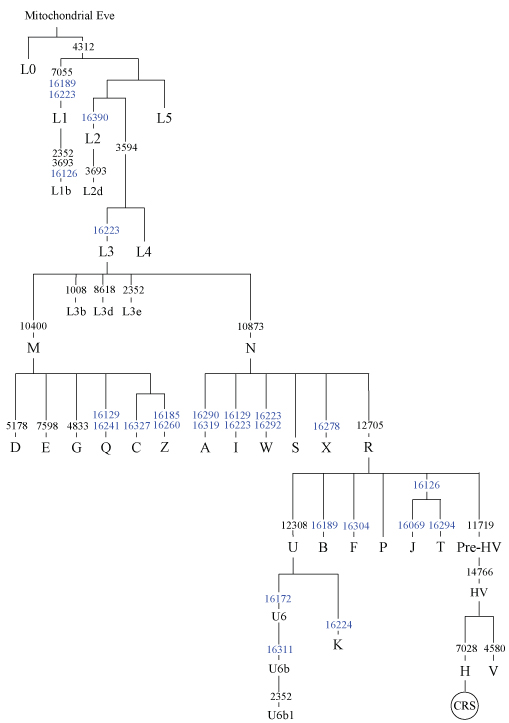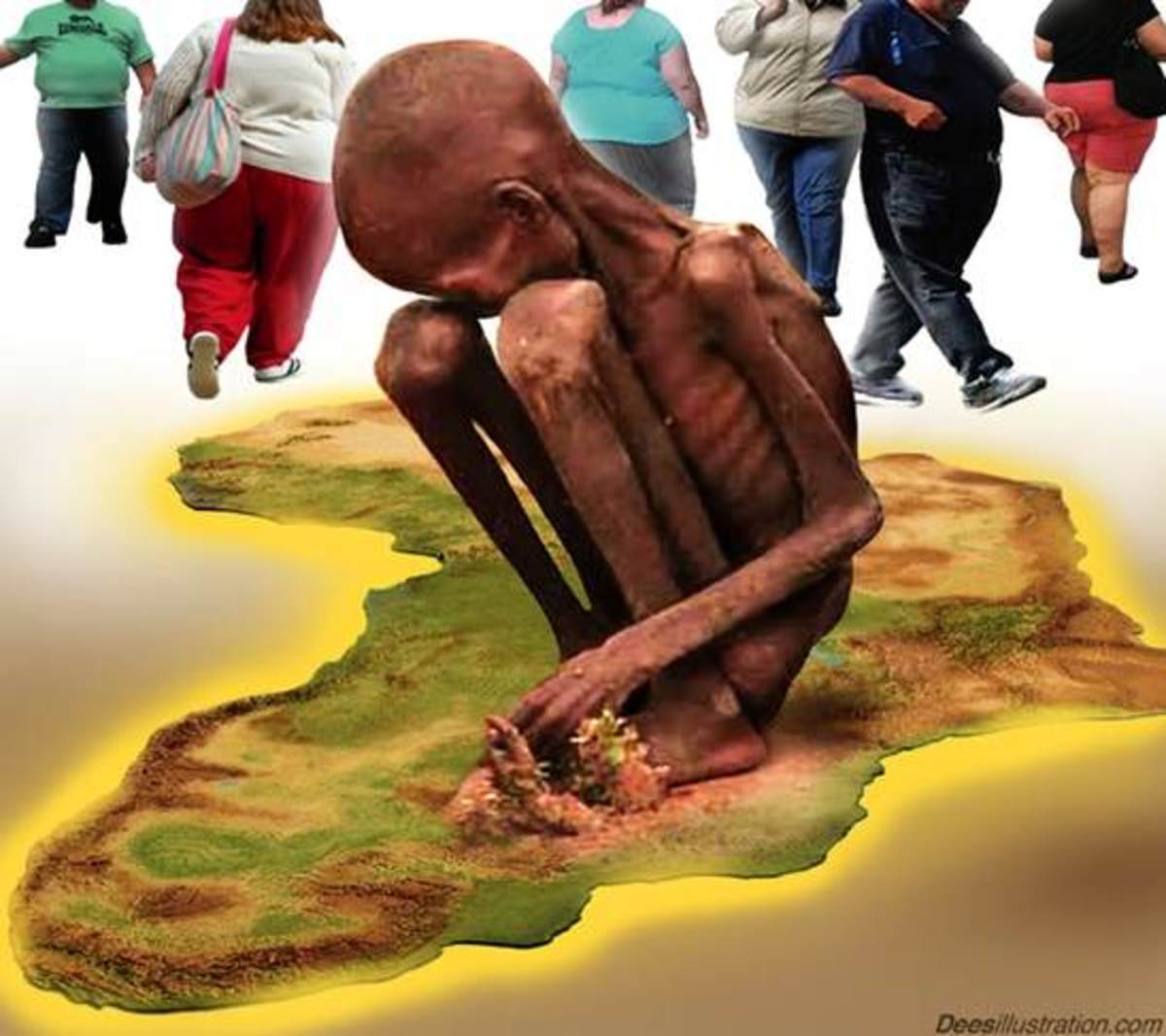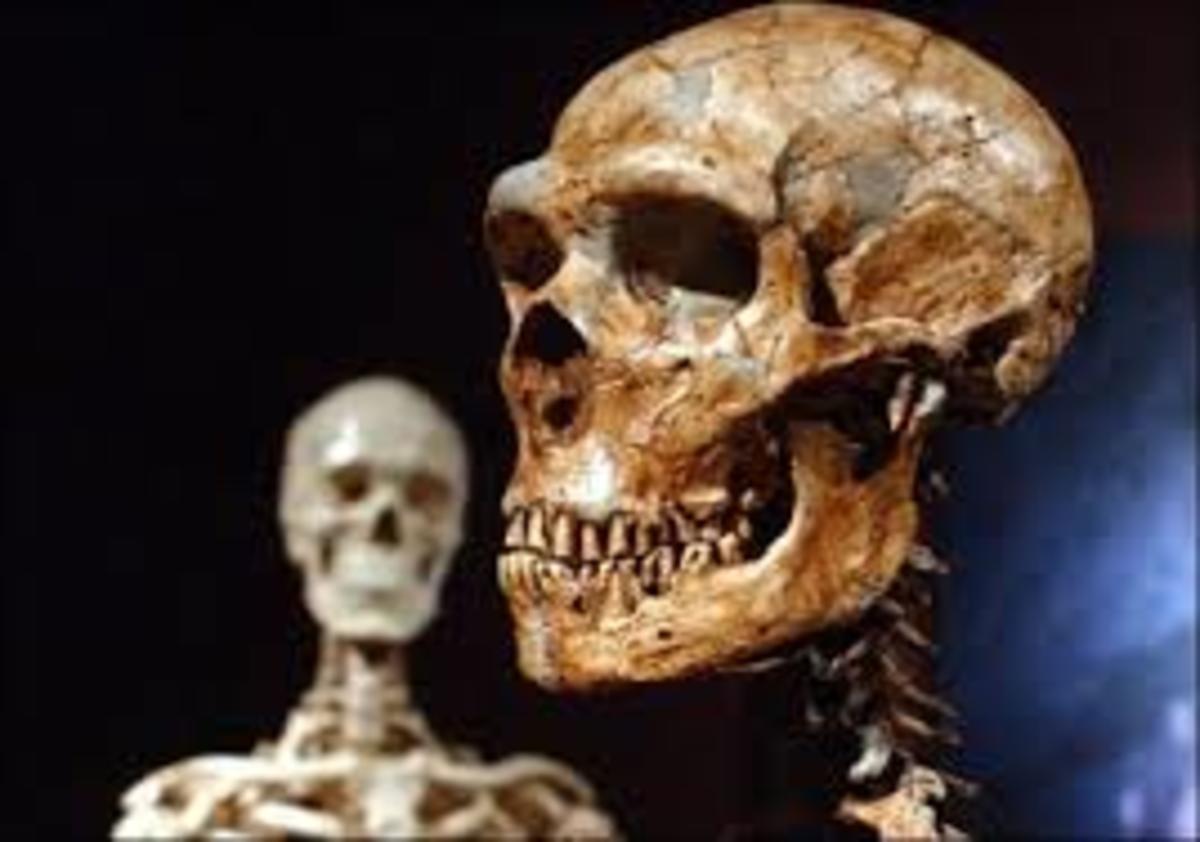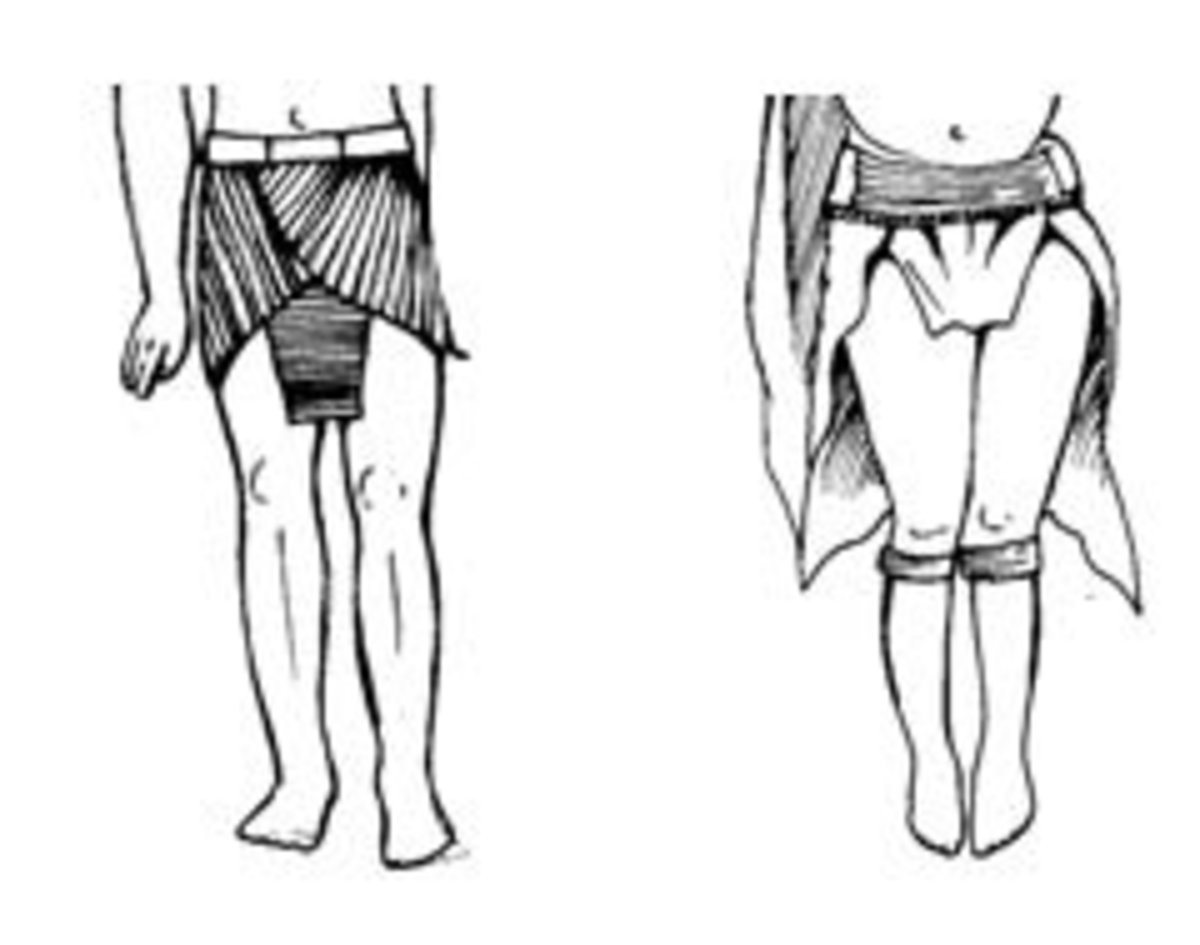Genealogy and DNA testing using Mitochondria
The story of mankind
Homo Sapians evolved as a distinct species in East Africa some 195,000 years ago. We are creatures of the Ice Age (in that throughout the existence of our species the polar regions have been ice-capped) and seem to evolve when the ice expands (glacial periods) and spread out across the planet when the ice retreats (interglacial periods).
We first appear towards the middle of a glacial period known as the Wolstonian Stage (352,000 to 130,000 years ago), which is significant as it would have meant the Sahara was wet and most of Africa would have been green and hospitable. The original group appears to have been no more than 2000 individuals. From East Africa, Homo Sapians moved to colonise the rest of Africa.
However the end of the Wolstonian glacial period would have meant the Sahara drying, and Homo sapians living in Eithiopia would have tried to escape the encroaching desert. Around 100,000 years ago, a group of humans managed to leave Africa, crossing the Red Sea at it's narrowest point, into Arabia and then following the coast into Asia. By 70,000 years ago, most of Asia was colonised by humans to the Arctic circle. But then between 65,000 years ago and 50,000 years ago, climate entered another glacial period and became bitterly cold. People retreated south again, looking for new places to live. The first wave of people pushed into Europe about 40,000 years ago, and into the Americas about 15,000 years ago.
However as people moved around, they encountered different environments, and some lines of people perished and other lines of people flourished depending on whether they had the characteristics to survive their environments. This was natural selection at it's most brutal.
The other surprise is where people end up - you can do a DNA test and find that your ancestors lived in the most surprising areas of the planet and that you are connected to populations you would never have thought of. As we shall see, Europeans and Australian Aboriginals have more in common genetically, than Europeans and Southern Indians.
How mitochondria helps trace population ancestry
Mitochondria is a sequence of DNA which is passed from the mother to all her children (male or female) and exists inside human cells but outside the nucleus of the cell. It's only passed down by the mother as it is in eggs but not sperm. It is usually passed unchanged from mother to child, but over the course of the last 150,000 years, some small differences have crept into the mitochondrial DNA. This is important because the changes usually pinpoint a shift in evolution.
Because some family lines die out (due to no children being born to females), some mitochondrial lines also die out. All the human population on the earth at present can trace back to a single woman, known as "Mitochondrial Eve". Of course the original ancestral population in East Africa would have had many women (at least 1000), but their female children have long since died out (though the genes from their male children may have survived by marrying Mitochondrial Eve's female children). In terms of an unbroken mother-daughter line, only Mitochondrial Eve's descendants still live.
Her descendants then split off into branches, and a DNA genealogy test can reveal which branch you are descended from.
As you can see from the graphic below, everyone outside Africa is descended from the branch L3 (the numbers shown in the graphic above the letters indicate at what point in the DNA sequence there is a new marker). Everyone in the later branches contains all markers from the earlier branches - a new branch is created when an additional marker suddenly appears.
Lots of people find it hard to get their heads around the idea that we are all descended from east africans. But in the same way that we know if a child belongs to it's parents by doing a simple DNA and blood test (for example it's impossible for a child with blood-type B to be born to parents with blood A because the blood type gets passed from parent to child), we can go back in time to see who we are descended from.
If we weren't descended from east africans, there would be no african marker in our mitochondria. But everyone outside Africa shows the East African L3 marker, which turns up in East Africa around 100,000 years ago (we have DNA from human bones in East Africa from this period) and is still present in modern east Africans (Kenyans, Ethiopians, Ugandans etc). The only people on the planet without the L3 marker are in parts of west and central africa - they share with the rest of us the earlier african markers, but clearly got cut off from east africans before the east africans moved to colonise the rest of the world. Thousands of DNA tests have been carried across the world to establish this - the Chinese did a massive study of Chinese DNA because they couldn't believe that they were really Africans under the skin, but every single sample without exception showed the East African L3 marker.
The dating of the branches is based on carbon dating human remains found across the world (to establish the time) and then DNA testing to check the markers. Unlike flesh, bones remain perpetually in the ground - the don't decay. If humans lived in a given spot, there will be bones. The earliest Homo Sapian bones are found in East Africa dated to around 195,000 years ago. We can track the time humans took to move around the world from Africa by dating the earliest bones found in a given spot.

The Asian populations
It's known from archaeological remains that when Homo Sapians left Africa, some followed the coastline of Arabia and then continued down the western coast of India. Others headed straight up into central Asia reaching the Arctic circle 70,000 years ago. Both groups would have looked the same and had the same L3 Mitochondria as the people they left behind in East Africa. But along the way they encounted climate change and their Mitochondria starts to evolve.
Branch M
"M" is the oldest, dating back 75,000 years ago, possibly in relation to the eruption of a super volcano Mount Toba, which sent ash clouds across the Indian sub-continent, laying sediment several metres deep. The effect would have been like Pompei only on a ginormous scale. Yet archaelogical evidence shows that some humans in the sub-continent survived the volcano. But they evolved as well. The "M" branch is heavily concentrated in southern India, and southern Indians have the same dark skin as Africans but look quite different. Their features are fine and their bones very small - was this due to only small people who were able to shelter from the volcanic ash in tiny nooks and crannies surviving? And how on earth did they manage to survive when most of the sub-continent was smothered in ash which meant that even migrating thousands of miles brought no relief? It's been noted that there is a very sharp contrast between south India and north India in terms of the mathematic ability of the two populations, with south India ahead by miles and this mental ability of the survivors might have helped them cope.
M2, M3, M4, M5 and M6 are found in heavy concentrations in Southern India and Bangladesh.
M7 is found in Japan.
The following sub-branches of M are also found in Asia:
- The sub-branches "C" and "Z" are found in Siberia (and C has also been found in Native Americans due to the wave of Siberians that crossed into Alaska 15,000 years ago).
- "G" is found in north-eastern Siberia - and it is the only Siberian branch that is not found in the Americas.
- "D" dates back 60,000 years and is found in central and north-east asia (and also among native Americans, indicating that people from this branch crossed into Alaska).
- "E" is found in southern Asia - the Malay peninsula, Papua New Guinea, Borneo, Pacific islands and also in Taiwan and the Philippines and
- "Q" is found in the southern Pacific islands.
Branch N
The parent branch "N" originates 65,000 years ago (around the time of an advance in the Ice Age). It affects the group that went north after leaving Africa and then had to retreat south from the Arctic circle as the ice advanced. Clearly the severe extreme cold caused an evolutionary change in the Mitochondrial DNA.
N is found in modern Western Asia and the Middle East (Saudi Arabia and Turkey).
The sub-branches of "N" are the most surprising of all
- "R" the Indo-European mother whose descendants populate Europe, Iran and the Caucasus, as well as the Far East and indigenous Australia
- "S" which is found in Australian Aboriginals.
- "W" is found in Northern Pakistan,
- "A" is found in Siberia, Eskimos (and Native Americans) and among 7% of the Japanese, and
- "X" is found in Southern Siberia and eastern europe.
Branch "R" further sub-divides into
- "F" which is found in eastern China and Japan,
- "B" which is found in China, Korea, Japan, Vietnam, Malasia, Indonesia, Tibet, Mongolia, and the Philippines,
- "P" which is found in Australian aboriginals, and
- "J" which is found in the near east, Caucasus and Europe.
- "H" and "V" both of which are only found in Europe
- "U" (U1 in the middle east and Mediterranean, U2 in North India, U3 in the Caucasus and among Roma populations, U4 in Europe, U5 in Europe, U6 in north Africa and Iberia, U7 in Iran and North India esp Gujurat, and U8 which is found among the Basques).
It seems clear that when Humans left Africa, the ones who took a southern route into India and South east Asia (branch "M") were affected differently by climate to the ones who went into north Asia. The south Asians were affected by the super-volcanic eruption, but not affected at all by the periodic Ice-Age advancements (glacial periods). Branch "N" which went into Northern Asia and then experienced two glacial periods circa 65,000 years ago and 25,000 years ago, ends up dispersing very widely indeed in the face of the advancing ice, and thus ends up with big differences in how they looked.
The European Branch
Modern humans reached Europe about 40,000 years ago. Europeans mainly belong to branches H, V, T, K, J, U and X.. Therefore European branches are sub-branches of branch R (which is a sub branch of branch N). Europeans are mainly descended from the Indo-European woman R whose descendents populate Europe, Western Asia, the Middle East and Northern India, with a small group descended from branch X (a Siberian lady).
They start off brown-skinned, but then about 25,000 years ago encounter cataclysmic climate change in the form of another advancement of the Ice Age. Humans need sunlight to produce vitamin D, but too much sunlight causes cancer - hence people in tropical areas are dark-skined because the melanin blocks sunlight, only letting in enough to produce the required Vitamin D. In Europe however with it's weak sunlight, dark skinned people would have developed rickets as they were blocking too much of it. Rickets would have collapsed the pelvic bones of women, making it impossible to give birth. The only people who would have survived would be those whose skin was lightening. (There is a modern echo of this - Asian families in Britain are prone to Vitamin D deficiencies and rickets and they've been advised to seek out as much sunshine as possible - it will be interesting to see if their descendants start to lighten colour over time).
The company Oxford Ancestors has found seven mitochondrial ancestors in Europe and have picturesquely named them as clan mothers.
The clan of Ursula (branch U5) is the oldest group in Europe, dating back to the original push into Europe from Arabia, 40,000 years ago. 11% of Europeans are descended from her, and are found all over Europe, but particularly concentrated in Western Britain (Celtic Britain) and Scandinavia. It's known that Britain and Scandinavia were uninhabitable in the Ice Age circa 25,000 years ago, so these people probably lived in current Iberia (Spain) and then pushed north into Britain and Scandinavia once the Ice Age ended, probably because the retreat of the Ice caused Spain to turn arid.
The clan of Xenia (branch X). This is the second oldest group in Europe (though in terms of evolution is much older than branch U), resulting from the second migration 25,000 years ago from Russian Asia. 7% of Europeans are descended from her and they are concentrated in eastern Europe, though they are also present in central Europe. Interestingly, 1% of Native Americans (Ojibwa and Sioux) are also descended from Xenia, indicating that while most of these Siberian people pushed into Europe, some headed east and crossed into the Americas from Alaska.
The clan of Helena (branch H). This is the biggest group (41% of Europeans are descended from Helena), and thus the most successful. Helena originates 20,000 years ago in Dordogne, France. Dordogne is very important in European history. When the ice-age descended about 25,000 years ago, humans had to retreat south, as northern europe as far as the Dordogne was covered in thick ice several miles deep which meant that nothing could grow and no animals could survive, hence no food was available (Britain at this point was completely uninhabitable). However the valleys of Dordogne had a microclimate that supported life and the reason most of Europe is descended from Helena is because her descendants uniquely had the best chance of surviving due to their environment. By contrast, most of the descendants of the other clan mothers would have been wiped out apart from a few hardy survivors.
The clan of Velda (branch V. Only 4% of Europeans are descended from Velda. Velda originated 17,000 years ago in North West Spain. Her descendants are found in Western and northern Europe with particular concentrations in Finland and Norway (no one has any idea how they got there).
The clan of Tara (branch T). Tara originates 17,000 years ago in Tuscany, Italy. Less than 10% of Europeans are descended from her and live in southern and western Europe - with particular concentrations in Ireland and Western Britain (how did they get there? During the Roman period?).
The clan of Katrine (branch K). Katrine originates 15,000 years ago in the southen Alps and 10% of Europeans are descended from her. Her descendants still live in northern Italy, but have also spread north into central and nothern europe.
The clan of Jamine (branch J). Jasmine originates in the Middle East and her descendants push into Europe about 8500 years ago, through Turkey, crossing the Bosphorus into Greece. 12% of Europeans are descended from her. Jasmine is especially important because her descendants had abandoned hunter-gathering and started farming and lived in organised settlements. In other words, Jasmine brings the first civilisation and the agricultural revolution into Europe from where it originated in Mesopotamia.
The African branch
Africa of course is where it all started. Mitochondria Eve lived in East Africa and her descendants spread across Africa and then the world.
L0 and L1 are believed to be the mitchondria of the grandaughters (or great great grandaughters to the power of an unknown number,) of "Eve" and originated around 145,000 years ago. Modern populations with this mitochondria live in west Africa and amongst the Bantu in central africa.
L2 is common in sub-saharan Africa and originated about 100,000 years ago.
L3 is common in modern East Africa, and humans with this mitochondria left Africa from East Africa crossing the Red Sea into Arabia around 100,000 years ago. Everyone outside Africa has the L3 marker (as well as more recent markers depending on which branch they are).
L3d, a sub-branch of L3 exclusive to Africa, originated about 30,000 years ago and is found mainly among West Africans and African Americans (because the slave trade mainly involved West Africans).
The other sub-branches of L3 populate the rest of the world and are described when discussing the populations of other continents.
The Americas
The first people to populate the Americas entered that continent around 15,000 years ago.
These populations had mitochondria that are sub-branches of Branch M (C and D) and of branch N - (A, B and X). X is only found in North America. the others are found in both North and South America..
A, B, C, D and X are all from Siberia/east Asia and it is believed that they crossed into the Americas from Alaska during a waning of the ice-age, when there was a land bridge across the two continents.
Related page: Mitochondria of famous people







